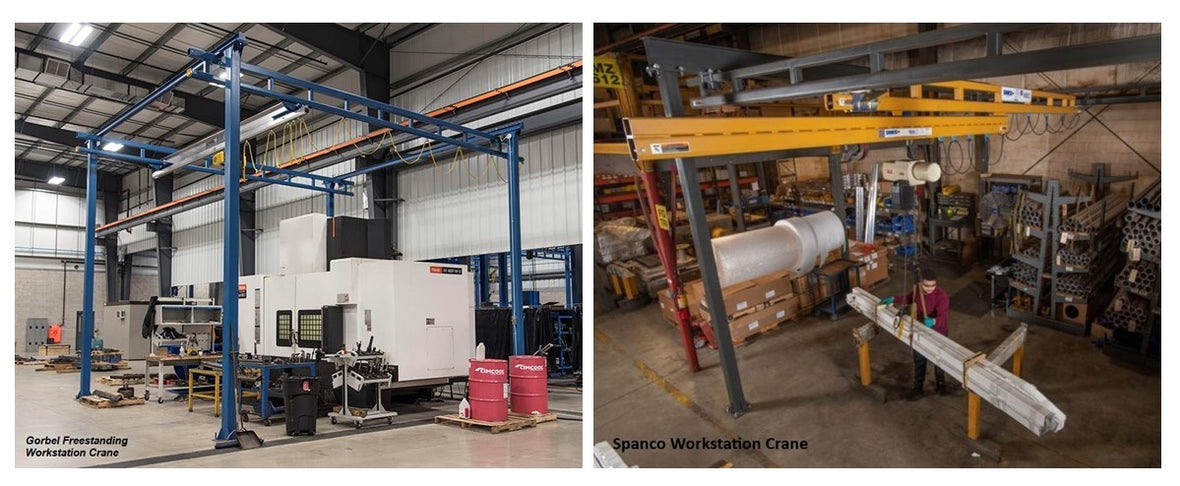
Workstation Rail Systems
Andrew T. Litecky
Welcome to The Hoist Guy's Blog, where our resident hoist guy, Andrew T. Litecky, shares his industry knowledge and experience. Today he’s here to discuss one of the most significant improvements in overhead material handling in the last half century in the US market, the advancement of enclosed track, commonly known as “workstation rail”.
What is a Workstation Rail?
In workstation crane systems, the trolley wheels, either steel or non-metallic, run inside the enclosed metal track that is usually square or rectangular in shape. Originally designed for the automotive assembly lines, the ease of use has brought the enclosed track, from capacity 250 lbs. through 4,000 lbs., into the realm of the first choice for light capacity crane and monorail systems.
Workstation Cranes Then & Now
The original intent for this track was to be positioned as low to the floor as possible, with bridges as short as possible, for ergonomically approved repetitive motions. As the demand for enclosed track grew, so did its uses, limits and parameters.
The concept and design of installing a low-capacity crane system into a workspace with no support steel was previously a significant engineering and fabrication task. Now, with the use of pre-engineered “erector set” type kits, it is an everyday occurrence. In a 10’ wide x 12’ high x 20’ long rectangular shaped room, a simple workstation rail system can be installed, consisting of four columns bolted to the floor, with two runways, a push bridge and a push trolley. If overhead support steel is available, the workstation crane system can be ceiling mounted, and the columns eliminated.
Workstation Crane Options
American manufacturers, such as Spanco and Gorbel, started offering workstation crane kits with room dimensions defined by the X-Y-Z hook travel. The “X” motion of the hoist (lifting up and down) can be manual or can be powered. A variety of options are quickly and easily quotable, including special applications such as powered tractor drives. Standard controls are variable frequency drives for soft start and soft stop of both the bridge and trolley.
Enclosed Rail Construction Options
Construction of the workstation rail can be steel or aluminum, and spans typically vary from 10 feet to 34 feet in either material. However, longer spans require additional support columns or ceiling hangers. And while aluminum is more expensive, it’s easier to move the load along an aluminum runway.
Enclosed Rail Electrification Options
Standard electrification includes non-metallic festooned flat wire cable with trolleys that ride inside the rail, behind the trolley and the bridge or monorail, or on the runway behind the end trucks. Four conductor #14 flat wire is normally the standard electrification. A “parking extension” can be added to either the monorail or the runway, to store the flat wire trolleys. This provides for the maximum movement of the trolley on the monorail or the bridge on the runway.
Alternatively, special electrification can include either Magnetek “Electro-Bar Elite” or Conductix “Boxline 842. These electrification systems are preferred by some to eliminate festooned flat wire hanging below the track and into the work space. These systems are suspended from the top truss of the track and use a collector trolley, for smooth, full span electrification.
Benefits of an Enclosed Track Crane
Enclosed track workstation cranes revolutionized overhead material handling, providing a simpler, cost-effective solution to low capacity lifting in workspaces with no support steel. To fully understand the benefits and determine if a workstation crane is right for your application, it’s helpful to compare them to other overhead lifting systems.
Enclosed Track Cranes vs. Bridge Cranes
Why choose an enclosed track workstation crane instead of an I-beam bridge crane? The pre-engineered workstation crane with its ease of motion has a price advantage over an engineered, fabricated bridge crane system, especially in capacities less than 2 Tons.
Enclosed Track vs. Patented Track
While both enclosed track and patented track are used to build overhead material handling systems, they are completely different types of material with different purposes. Patented Track has an I-beam shape, but it’s made with a mild steel flat top flange, mild steel web (the vertical section), and a high-carbon steel lower flange. It’s primary use is for high production manufacturing, such as in foundries and production assembly. It’s also more expensive than an enclosed track rail system.
Enclosed Track System Uses
The most frequent users of enclosed track workstation systems are seeking a cost-effective system within the parameters of 10’ to 20’ work space. Enclosed track systems, often paired with electric chain hoists, are useful for light assembly, manufacturing operations and in warehouses. They’re often used in stone lifting facilities, for metal fabrication and in maintenance shops.
Since 1969, Shupper-Brickle Equipment has provided overhead material handling equipment to the Mid-Atlantic states and worldwide. We can help you determine if a workstation crane is right for your application. Contact us for more information or a free estimate on the best equipment for your application.


